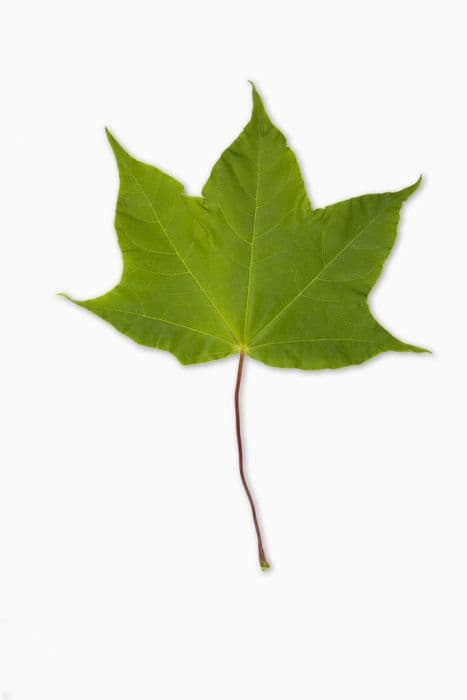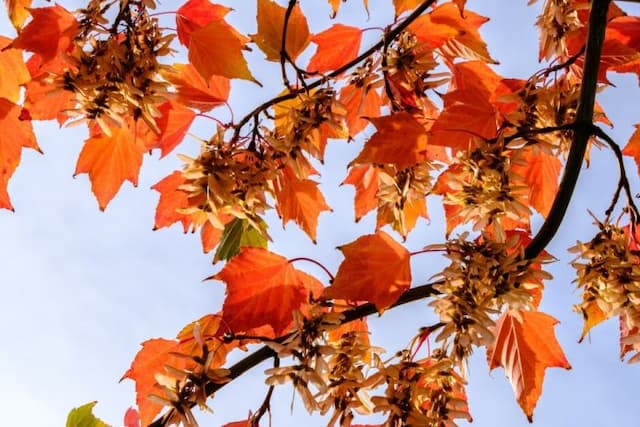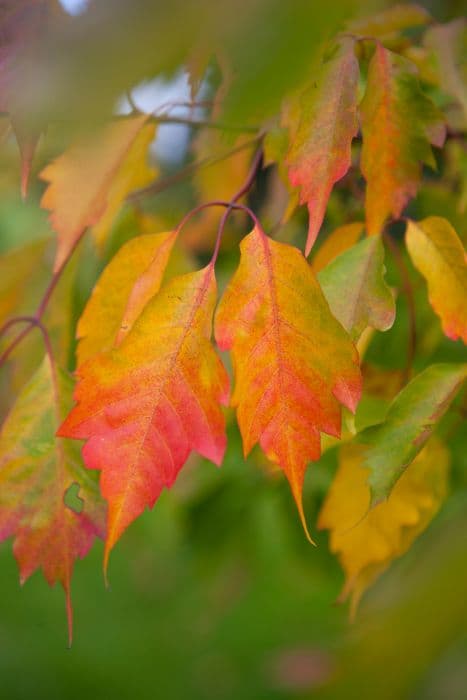Redvein Maple Acer rufinerve

ABOUT
The plant commonly known as Grey-barked Maple is recognizable by its attractive bark and foliage. The bark, true to its name, is a striking grey with prominent vertical stripes that often take on a reddish-brown or greenish hue, adding a unique texture to the appearance of the trunk. These stripes can sometimes appear almost as if they are effectively exfoliating from the trunk. The leaves of this plant are equally appealing, featuring a classic maple shape with three or five lobes, mostly three, and finely serrated edges. The top side of the leaves exhibits a rich green color, while the underside tends to be a lighter shade, sometimes with a bluish or whitish touch to them. During the seasonal changes, the foliage transforms into a stunning display of color. In Autumn, the leaves take on brilliant hues, typically transitioning through shades of yellow, orange, or red before they eventually fall. The contrast between the colorful fall leaves and the distinctive grey bark is particularly striking. The plant also produces flowers and fruits that add to its visual interest. The flowers are small, yellowish-green, and appear in clusters. Following flowering, winged fruits known as samaras develop. These fruits, typical of maples, can often be seen twirling to the ground like little helicopters during late summer to fall. The samaras are initially green, turning to a brownish color as they mature and dry out. Throughout the year, the Grey-barked Maple's combination of unique bark, lush green foliage, and seasonal color changes along with its samaras make it an attractive addition to any landscape where it can be appreciated for its beauty and natural elegance.
About this plant
 Names
NamesSynonyms
Redvein Maple, Grey-barked Maple, Japanese Maple.
Common names
Acer rufinerve Siebold & Zucc.
 Toxicity
ToxicityTo humans
The most common name for Acer rufinerve is Grey-barked Maple. There are no well-documented cases of toxicity in humans from ingesting parts of the Grey-barked Maple. Typically, members of the Acer genus are not known for being poisonous to humans. As such, no specific symptoms of poisoning or toxicity are generally associated with this plant.
To pets
For pets, the Grey-barked Maple is not commonly listed as a toxic plant. The Acer genus, which the Grey-barked Maple belongs to, does not typically pose a risk of toxicity to pets such as dogs and cats. There are no specific symptoms generally associated with the ingestion of this plant by pets, and toxicity is not expected to occur with the ingestion of its parts.
 Characteristics
CharacteristicsLife cycle
Perennials
Foliage type
Deciduous
Color of leaves
Green
Flower color
Yellow
Height
20-30 feet (6-9 meters)
Spread
15-25 feet (4.5-7.5 meters)
Plant type
Tree
Hardiness zones
5-7
Native area
Japan
Benefits
 General Benefits
General Benefits- Ornamental Value: Acer rufinerve, commonly known as Grey-budded Snakebark Maple, is appreciated for its decorative bark and attractive foliage, enhancing garden aesthetics year-round.
- Habitat Support: The tree provides habitat and food for wildlife, such as birds and insects, contributing to local biodiversity.
- Shade Production: It offers shade in gardens and parks, creating cooler areas during hot weather, which is beneficial for both humans and understory plants.
- Seasonal Interest: With its colorful autumn foliage, the Grey-budded Snakebark Maple adds seasonal interest to landscapes, parks, and gardens.
- Erosion Control: The tree's root system helps stabilize soil, reducing erosion on slopes and in riparian zones.
- Wood Production: Although not a primary timber species, the wood of Acer rufinerve can be used for small-scale woodworking projects and crafts.
 Medical Properties
Medical Properties- This plant is not used for medical purposes.
 Air-purifying Qualities
Air-purifying QualitiesThis plant is not specifically known for air purifying qualities.
 Other Uses
Other Uses- Acer rufinerve, also known as grey-budded maple, can be used as a natural dye source; different parts of the tree produce various colors when processed.
- Woodworkers value the grey-budded maple's timber for making musical instruments such as violins and guitars due to its acoustic properties.
- Grey-budded maple's wood is also used in fine woodworking for crafting decorative veneers, inlays, and furniture because of its attractive grain.
- The sap of the grey-budded maple can be used to make maple syrup, although it's less common than using the sap from its relative, the sugar maple.
- Young shoots and leaves of the grey-budded maple can be used for ornamental purposes in floral arrangements and bouquets.
- In bonsai, the Acer rufinerve is sometimes used for its interesting bark texture and foliage, creating miniature landscapes for enthusiasts and collectors.
- Acer rufinerve leaves may serve as a food source for certain species of Lepidoptera, which could be useful for butterfly gardening to attract and sustain these insects.
- The tree can be planted as a component in agroforestry systems, combining agricultural and forestry technologies to create more diverse, productive, and sustainable land-use systems.
- The tree is sometimes used in reforestation efforts, especially in temperate zones, due to its hardiness and adaptability to various soil types.
- Acer rufinerve is utilized for creating natural shade in gardens and parks, providing cool areas during hot summer months and contributing to the landscape’s aesthetic.
Interesting Facts
 Feng Shui
Feng ShuiThe Grey-Barked Maple is not used in Feng Shui practice.
 Zodiac Sign Compitability
Zodiac Sign CompitabilityThe Grey-Barked Maple is not used in astrology practice.
 Plant Symbolism
Plant Symbolism- Strength and Endurance: The Acer rufinerve, commonly known as the Grey Striped Maple, is symbolic of strength and endurance due to its hardy nature, being able to withstand a variety of climates and conditions.
- Resilience: Similar to other maples, the Grey Striped Maple represents resilience, as it is capable of bouncing back and thriving even after experiencing harsh circumstances.
- Beauty and Uniqueness: The distinctive green bark with white striations of the Grey Striped Maple symbolizes beauty and uniqueness, suggesting that beauty comes in many forms and often lies in the distinctive traits of individuals.
- Growth and Expansion: Like many trees, maples are often associated with growth and expansion, representing the idea of expanding one's horizons and personal development.
 Water
WaterThe Redvein Maple should be watered deeply, allowing the soil to dry out slightly between watering sessions. During the growing season, it may need watering every week, especially if the weather is dry. Aim for about 1.5 gallons per week for a young tree, adjusting for rainfall and soil conditions. In winter, reduce the frequency, but do not allow the soil to become bone dry. Monitor the soil moisture levels to ensure consistent hydration without waterlogging the tree.
 Light
LightThe Redvein Maple thrives in a location with full sun to partial shade. Ideally, it should receive at least four hours of direct sunlight daily but should also be protected from the harsh afternoon sun if possible. An eastern or northern exposure can provide the optimal light conditions for a healthy growth.
 Temperature
TemperatureThe Redvein Maple prefers moderate temperatures and can generally tolerate temperatures down to about -20°F to -30°F for short periods. The ideal temperature range for this maple is between 60°F and 80°F. Sudden temperature fluctuations can be stressful for the plant, so try to provide a stable environment, especially during the growing season.
 Pruning
PruningPrune the Redvein Maple to shape the tree, remove any dead or diseased branches, and improve air circulation. The best time to prune is in late winter or early spring before the sap begins to flow. Pruning should be done annually or as necessary to maintain the health and aesthetics of the tree.
 Cleaning
CleaningAs needed
 Soil
SoilThe Redvein Maple requires well-draining soil with a slightly acidic to neutral pH of 5.5 to 7.0. The best soil mix for this tree should include organic matter such as peat moss or leaf mold, combined with loamy soil and sharp sand to improve drainage.
 Repotting
RepottingRedvein Maples do not require frequent repotting; it's generally recommended to repot these trees every 2 to 3 years, allowing them to settle and grow without disturbing their root systems too often.
 Humidity & Misting
Humidity & MistingThe Redvein Maple thrives in moderate humidity conditions. It can adapt to the ambient outdoor humidity and does not require any special humidity adjustments in the garden environment.
 Suitable locations
Suitable locationsIndoor
Grow it in bright, indirect light and well-draining soil.
Outdoor
Plant in partial shade, shelter from strong winds, mulch well.
Hardiness zone
5-8 USDA
 Life cycle
Life cycleThe life cycle of Acer rufinerve, commonly known as the Grey-budded Maple, begins with seed germination, typically occurring in the spring when soil temperatures are favorable. The seedlings emerge and grow into juvenile saplings, developing a root system and foliage while relying on stored seed energy. As saplings mature into young trees, they undergo a period of extensive growth, increasing in height and girth, and their bark begins to exhibit the characteristic grey-budded appearance. These trees reach reproductive maturity, producing flowers that are wind-pollinated, leading to the development of samaras, the winged fruit typical of maples. After wind dispersal, the samaras release seeds, continuing the cycle, while adult trees can live and reproduce for several decades, contributing to forest growth and dynamics. Throughout its life, the Grey-budded Maple experiences annual cycles of leaf growth in the spring and senescence in the fall, with leaves changing color before abscission.
 Propogation
PropogationPropogation time
Late winter
The most popular method of propagating the Acer rufinerve, commonly known as Grey-budded Snake-bark Maple, is through seed collection and sowing. The best time to collect seeds is in the fall when they have matured and have a brownish color. Once collected, the seeds require a period of cold stratification to break dormancy, which can be achieved by mixing the seeds with moist sand and storing them in a refrigerator for 90 to 120 days at a temperature around 34 to 41 degrees Fahrenheit (1 to 5 degrees Celsius). After cold stratification, the seeds can be sown in a well-draining soil mix, ideally in spring. They should be sown at a shallow depth, barely covered with soil, and kept moist but not waterlogged until germination occurs, which can take a few weeks to a few months depending on conditions.









